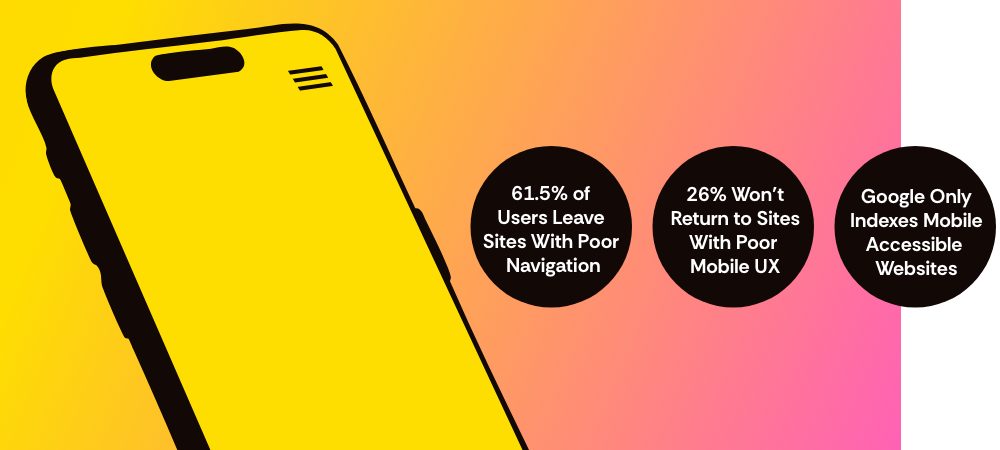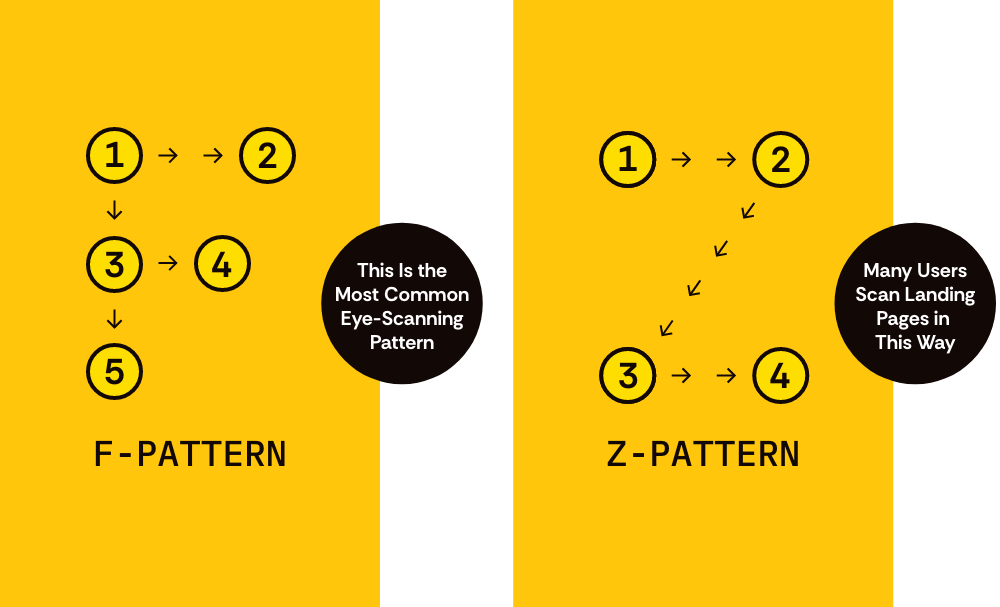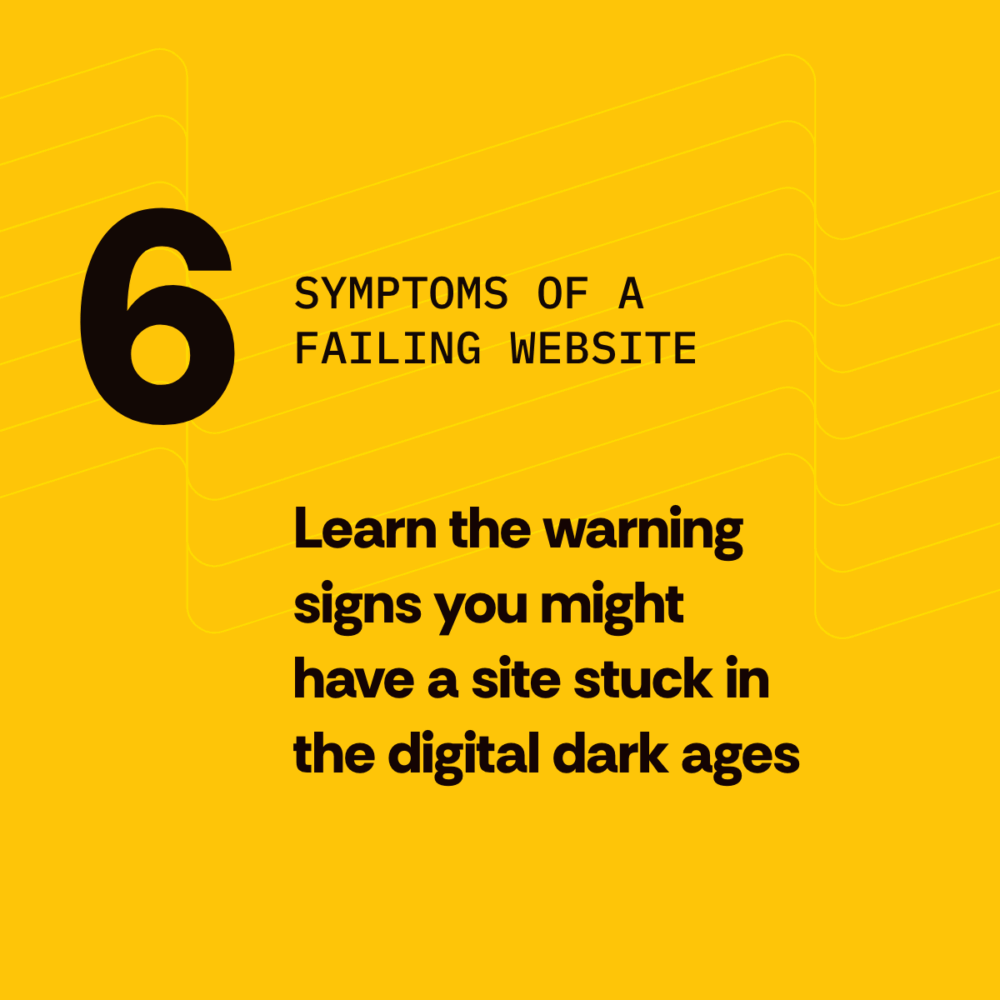I’ve seen A Knight’s Tale probably three dozen times since it came out. I just love the part when the heroes say, “You have been weighed, you have been measured, and you absolutely have been found wanting” to the villain after he lost the joust. I can’t help but think back to those words whenever I visit a site that’s been left to rot. That’s because—by refusing to invest in fixing a website that clearly needs help—it’s clear that business has “absolutely been found wanting.”
Allowing an outdated, broken website to exist is basically saying to everyone in the online world that you don’t care about your users. And, that’s a real shame for a lot of reasons, but the biggest of which is that a truly great website can “change your stars.” When your site’s essentially broken, your customers are going to struggle to use it. And, here’s more bad news: A wonky website also hurts other digital marketing efforts. But more on that in a little bit.
After a couple of decades working in web design, I find it easy to spot an underperforming website because it’s my job. But if this isn’t your world, it can be easy to miss subtle signs that your website is on its way to becoming a digital graveyard. That’s why, with this article, I’m covering what you can do to review to “weigh and measure” your site like a pro to figure out if it’s time to prioritize budgeting money for a strategic redesign project. And, if you read all the way to the end, I’ll share specific things you can do when working with a web design agency to make sure you build the best possible redesigned site.
The importance of having an up-to-date website
Neglected websites can be expensive digital liabilities because they:
Fixing a website vs. settling
The cost of frustrating website user experiences due to lost leads is actually more expensive than just fixing a website. In fact, according to AccessibilityChecker.org, “the cost of remaining non-compliant far outweighs the time, effort, and money it takes to remediate a website.”
- Drive away potential customers (and increase the risk of lost sales). Users have choices. If your website is too frustrating to use, customers won’t think twice about going over to your competitors with more engaging, easier-to-use sites.
- Expose users to security vulnerabilities … Hello, compliance issues‽ Users are savvy. They pay attention to their web browsers when they display security warnings alerting them that sites have expired SSL certificates and other problems.
- Tarnish otherwise good brand reputations. We aren’t in the early days of the web anymore, when folks would give businesses a pass for rampant broken links and “under construction” animated GIFs as placeholders for content that should be online. Users are discerning. If they’re giving you their business, they expect you to show respect for their time by making web transactions easy for them. After all, you wouldn’t allow an unhelpful customer service rep to stick around, so why would you let a bad website hang out online and hurt your brand building?
6 symptoms of a failing website
There are a lot of factors that contribute to a website that doesn’t meet the basic needs of those who visit it, but—to help keep you focused on what most hurts your customers’ user experience—this article will detail the six most dangerous warning signs you might have a site stuck in the digital dark ages:
- Slow webpage loading
- Poor usability on smartphones
- Outdated content and visuals
- Info and resources are hard to find
- Little to no presence in search results
- Crumby conversions

Slow webpage loading
People have little patience for websites that take forever to load. In fact, research shows that if a website takes longer than 3 seconds to load, 40% of users will abandon it. Slow loading times frustrate your visitors and also negatively impact your search engine rankings, so you need to take this website flaw seriously.
Fixing a website’s speed
If your website doesn’t adapt to different screen sizes and devices, you’re missing out on a significant portion of potential customers. Designing your site so it’s mobile-optimized is critical for providing a better user experience for those coming to your site from smartphones.
Poor usability on smartphones
Have you taken a look at your site’s analytics lately? There’s a very good chance that it’s being used by those on smartphones as much (or perhaps more) than folks on desktops. In July 2025, 58.39% users across the globe using the web were doing so with mobile devices, followed by 40.04% on desktop computers (including laptops), and 1.57% on tablets.

Though every industry’s numbers might be slightly different and desktop users might still be your top group of website visitors, the numbers overall tell a clear story: The world’s website needs are changing. Don’t get left behind because you ignored the writing on the wall.
Fixing a website’s mobile user experience
If your website doesn’t adapt to different screen sizes and devices, you’re missing out on a significant portion of potential customers. Designing your site so it’s mobile-optimized is critical for providing a better user experience for those coming to your site from smartphones.
Outdated content and visuals
When was the last time you updated the content and visuals on your website? If the answer is more than a year ago, your website probably could use an update. Outdated information and imagery make websites look neglected and unprofessional.
Even little things, like a footer that still reads “© 2019” or calendar panels still pushing users to register for long-past events that were held in 2023, are the sort of things that make users pause and question if your website is accurate (at best) or if it’s safe to use (at worst).
(Note: Sometimes, the reason a site is out of date is that it’s just too hard to update. Having a lack of control over what’s published is another serious red flag that you’re overdue for a redesign!)
Fixing a website’s media asset troubles
Create a plan to regularly update your website’s visuals with fresh and relevant media to keep your audience engaged and coming back for more. Think about what cadence makes the most sense for your target audience. For some organizations, that might mean auditing and refreshing these assets quarterly or annually. For others with more repeat traffic on a day-to-day basis, going with a weekly or monthly refresh might be the right schedule.
Have you recently gone through a merger? Presenting a unified brand online takes more than just swapping in a new logo for your old one. Check out this article for a quick overview of some of the things you should know about web design after a merger.
Info and resources are hard to find
“Virtually all organizational sites are narcissistic and (at the same time) afraid and incomplete. [To remedy this ] answer your visitor when he asks, ‘Why am I here?'”—Seth Godin
Navigating your website should be intuitive and seamless for your visitors. If they struggle to find the information they’re looking for or get lost in a maze of confusing menus, they’re likely to leave and never come back. Poor navigation and user experience are major warning signs that your website is stuck in the digital dark ages.
Fixing a website’s disorganization issues
As part of the redesign process, look for ways to improve your content organization, starting with rethinking your navigation and how you bucket content. Think like your target audience and group like items and give prominent placement to the information they need the most to make it as easy as possible for your most important visitors to find what they’re looking for without any hassles.
Little to no presence in search results
Your website’s visibility in search engine results is crucial for attracting organic traffic. If your website is stuck in the digital dark ages, your search result page rankings are likely suffering because of outdated SEO practices, a lack of fresh and relevant content, and a poor user experience. That’s because developers who create search engine algorithms put their users’ needs first. The leaders at Google and Bing aren’t about to put their reputations on the line by sending users to unworthy destinations if they can help it.
“If I had an hour to solve a problem and my life depended on the solution, I would spend the first 55 minutes determining the proper question to ask, for once I know the proper question, I could solve the problem in less than five minutes.”—Albert Einstein
Fixing a website’s invisibility
At the root of all things SEO (or even generative engine optimization for that matter) is people. That “who”—specifically what they need and how they think—when used to drive decisions around a website’s design, messaging, and format are what set a great site apart from one that’s ignored. Invisibility isn’t just a problem solved by picking keywords with decent monthly search volumes and low competition then adding them to its pages.
To really see a difference requires putting your customers’ needs ahead of your business needs. You don’t have to ignore your goals. Instead, just use insights about your target audience to guide your site’s primary content creation and refinement decision-making.
Following this simple mindset to really help your leads (as well as get SEO best practices in place) are what it takes to shine on the web and become a site that search engines are looking for and want to reward by sending users to you.
Crumby conversions

Unless your website is just a vanity project, it should be a powerful lead generation and conversion tool. When you aren’t seeing a steady stream of new customers come through this marketing channel, it’s probably time to rethink your strategy and evaluate it—from top to bottom—to see where your site’s missing the mark.
Fixing a website’s challenges to convert
Websites often fail to turn visitors into prospects when they’re still using outdated lead generation tactics and lack of compelling calls-to-action. If you’re struggling to figure out what’s not working with your landing pages, it might be time to partner with an experienced web design agency to redesign and create a plan that maximizes your website’s potential.
The 4 things all savvy clients do to ensure they succeed when partnering with a website redesign agency
The only way to really deal with sites that have many weighty problems when simple repairs won’t cut it is to invest in a strategic overhaul. A website redesign requires shelling out a good chunk of money from your budget and time from your schedule, so it takes real vision and bravery to greenlight this work and make it a priority. And, if you’ve never led a site redesign project (or it’s been a while since you’ve been charged with fixing a website), you might be wondering what exactly you can do to maximize your ROI.
TBH Creative opened its doors over 20 years ago. During this time, our team has built a lot of websites. Here are the four things that you can do to get the most out of working with a web design and development partner (and end up with the best redesigned site possible):
- Be clear about what you’re trying to achieve: This takes knowing your audience and their needs as well as understanding your company’s priorities and differentiators. Being able to clearly and specifically share these critical details upfront helps us help you put your best foot forward online. It’s okay to talk about particulars once a strategy is set. Where projects get bogged down is when the upfront conversations are sidetracked by chats about random features (e.g., “our CEO wants a video of rabbits skiing wearing orange hats in the hero”).
- Be decisive: There are a lot of choices to make when you’re thinking through must-haves vs. nice-to-haves when fixing a website. But if you try to “design by committee” or overthink each small factor, the delays will compound. Making timely decisions is the best way to launch your new site on time. If you’re sweating the small stuff (and it’s truly inconsequential small stuff), that’s a sign to pause and make those items phase 2 to-dos to take care of after your initial redesigned site goes live.
- Be realistic: The possibilities seem endless when fixing a website. That said, you have to be reasonable when prioritizing and creating your redesign strategy. The good thing about modern web design solutions is that, when you partner with the right agency, you’ll end up with a scalable site. That means, even if you really want to add a blog but right now there’s no team to write its articles regularly (and that content won’t directly support business goals or meet a customer need), be practical and move this feature to a phase 2 wishlist as something to consider later as you grow and have thought-through more.
- Be engaged: It’s an overused cliché, but in great website redesign projects, it’s really true: “teamwork makes the dreamwork.” Whenever clients are all-in at each stage of a redesign project, they always end up with better sites. Your enthusiasm and passion for the project will keep us excited and also help you get your team on board, too (which will make it easier for you to call on them for help as you need it along the way).
Get TBH Creative’s help with fixing a website
Don’t let your website be a relic of the past. If your site has more red flags than green flags and you’re ready to get started on a full-blown redesign, TBH Creative can help.
Every website redesign project is different, and our experts are pros at helping clients navigate unknowns and getting the best out of their investment so they end up with sites that look great and perform great. How can we help you? Let’s talk.

